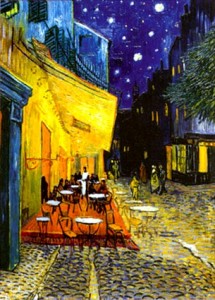Roger Cohen, again.
One needs to be either peculiarly observant or exceedingly self-absorbed to behold, in another’s writing, traces of one’s own. But for the second time in one week (!) I’m reading something by the estimable Roger Cohen (from today’s New York Times, here) that caused me to think of my own work. This one is not much of a stretch: for one thing, the theme is similar, for another, it’s not a particularly original sentiment being expressed. Reflecting on the present necessarily obliges certain types of people (sensitive, perceptive, or simply writers who may be little of either but, by being writers, have an innate compulsions they cannot control) to consider the past. Of course, in Cohen’s case, being well-traveled, well-read and more than a little erudite augments his powers of perception, and commentary:
Yet, for all its enduring seductiveness, Paris has ceased to be the city that I knew. The modern world has sucked out some essence, leaving a film-set perfection hollowed out behind the five-story facades. The past has been anaesthetized. It has been packaged. It now seems less a part of the city’s fabric than it is a kitschy gimmick as easily reproduced as a Lautrec poster.
Anyone who has been to Paris will be able to appreciate this. On the other hand, anyone who has been alive to see an old century collapse into a new one can apprehend some of what Cohen is expressing. Progress being what it is (people can celebrate or lament it, but it is ambivalent about its own powers to propel us forward), whether it brings about a better, or more evolved world is in the eye of the beholder, it simply ensures that old things get older and new things become increasingly commonplace. When it comes to consumables and what happens to food before and after it has been ingested, it’s difficult to deny that progress is positive. When it comes to the ever complicated case of culture, it is a dicier proposition. Old music performed by old(er) people, for instance, has an inherently nostalgic (but never sentimental–not good music anyway) element; it is living proof of a time that is already passing. The music may make certain types of people sentimental (or else wistful) but the music itself never is; unless it was designed to be sentimental in the first place, which disqualifies it from being good music.
What about more tangible or tactile things, like architecture or food, or old-fashioned things like (as Cohen notes) drinking during the day or smoking in public places? Simply put, the way we create and the way we interact is always evolving (or devolving, depending on one’s perspective) but it’s seldom static. Old ways will disappear, and that is when we turn to art in order to preserve what has passed us by.
(excerpt from The American Dream of Don Giovanni)
Columbus Plaza.
This must have struck the designers of this mid-60’s innovation as particularly ingenious, a new town and its new epicenter: a new discovery, a new country. Hard to imagine already, a time when Columbus was not a dirty word, the man not yet controversial, celebrated and honored with his special day. The man who claimed what the Conquistadors—and the Vikings before them—had not seen as potential property, failing as they did to recognize the real estate potentials. Admittedly, those other explorers were more committed to human conquest.
Now, at the end of the century—only three decades after its inception—the plaza, like its namesake, was showing signs of age, the cyclical whims of fashion and, worst of all, mortality. The upside, of course, being that what is no longer new now had character. And the plaza, with its distinct, entirely intentional European essence—the lake circling it like a canal—had been built to last. These days, it sulked silently with the jaded envy of an older sibling, the one who saw the younger sister receive an unjust proportion of attention and opportunity. In an unprecedented development, the last-born had received the dowry.
Singular and strange, there was nothing else like it in America; probably nothing else like it in the world, because if failed in all the unimportant ways. Perfect places, like Disney and Vegas or any inane theme park can have the miniature to-scale Eiffel Towers, the made-in-Japan cobblestone, the ethnic foods cooked by people in ethnic garb brought to the table by college kids with cultivated ethnic accents (the better the act, the better the tips). Whereas, the combination of real, and limited, resources of the myopic, but well-intended mindset of the late 1960’s, and the inexorable, impossible-to-imitate strains of a quarter century of fads, styles and influences, all conspired to make it seem at once an insufficient, but somehow superior facsimile—it’s virtue was an unintended, but naturally evolved singularity, its style and substance. An accidental symmetry, it could never be copied. This was obvious to anyone who has been to Europe, or any of the places depicted in theme parks and movies, for the over-stimulated senses but undeveloped, underutilized imaginations of Americans.
When one actually walks through the streets of Paris, the cobblestone is broken and scarred from centuries of feet, time and turmoil; the canals are naturally eroded and muddy, the occasional smattering of graffiti, the stapled signs and billboards, the cigarette butts, the smoke flowing from cars, sewers and mouths of the populace—all of these things, and a million more, are what make the place—any place—real and authentic. That is why one can spend less than five minutes in any city at Europe and get a palpable sense of history. The tradition of an old place which is awakened by and open to all the senses—in the air, the sights, the smells, the sounds and the things that are no longer there but still have left an indelible mark; whereas a week in Disneyland provides the equivalent of a CliffsNotes education—if that—of what the real world outside the golden, glittering, cage contains.

